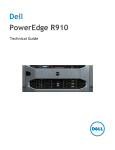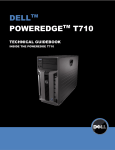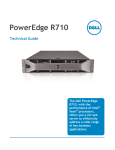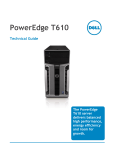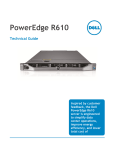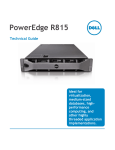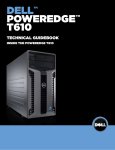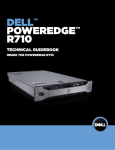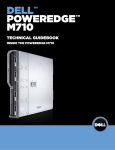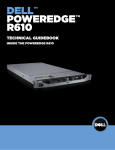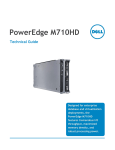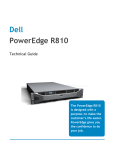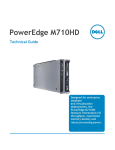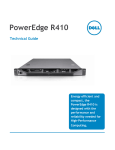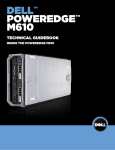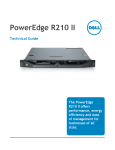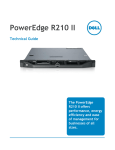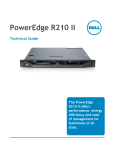Download Dell PowerEdge T710 Specifications
Transcript
PowerEdge T710 Technical Guide Inspired by IT professionals, the PowerEdge T710 is ideal for server consolidation. i Dell This document is for informational purposes only. Dell reserves the right to make changes without further notice to any products herein. The content provided is as is and without express or implied warranties of any kind. Dell, PowerEdge, Dell OpenManage, and ReadyRails are trademarks of Dell, Inc. Citrix and XenServer are registered trademarks of Citrix Systems, Inc. and/or one or more of its subsidiaries, and may be registered in the United States Patent and Trademark Office and in other countries. Intel and Xeon are registered trademarks of Intel Corporation in the U.S. and other countries. Broadcom is a registered trademark and NetXtreme is a trademark of Broadcom Corporation and/or its affiliates in the United States, certain other countries and/or the EU. Matrox is a registered trademark of Matrox Electronic Systems Ltd. Microsoft, Windows, Windows Server, and SQL Server are either registered trademarks or trademarks of Microsoft Corporation in the United States and/or other countries. Red Hat is a registered trademark of Red Hat, Inc. in the United States and other countries. Linux is a registered trademark of Linus Torvalds. Symantec is a trademark owned by Symantec Corporation or its affiliates in the U.S. and other countries. VMware and vSphere are registered trademark and vSphere a and ESX and ESXi are trademarks of VMware, Inc. in the United States and/or other jurisdictions. Other trademarks and trade names may be used in this document to refer to either the entities claiming the marks and names or their products. Dell disclaims proprietary interest in the marks and names of others. ©Copyright 2012 Dell Inc. All rights reserved. Reproduction or translation of any part of this work beyond that permitted by U.S. copyright laws without the written permission of Dell Inc. is unlawful and strictly forbidden. December 2012 | Version 4.0 PowerEdge T710 Technical Guide ii Dell Table of Contents 1 2 3 4 5 6 7 Product Comparison ........................................................................................... 7 1.1 Overview .................................................................................................. 7 1.1.1 Purposeful Design .................................................................................. 7 1.1.2 Energy-Optimized Technology .................................................................... 7 1.1.3 Advanced Virtualization ........................................................................... 7 1.1.4 Simplified Systems Management ................................................................. 7 1.2 Comparison ............................................................................................... 8 Key Technologies............................................................................................. 10 2.1 Overview ................................................................................................ 10 2.2 Processor Information ................................................................................. 10 System Overview ............................................................................................. 11 Mechanical .................................................................................................... 14 4.1 Chassis Description..................................................................................... 14 4.2 Dimensions .............................................................................................. 14 4.3 Weight ................................................................................................... 14 4.4 Front Panel View and Features ...................................................................... 14 4.5 Back Panel View and Features ....................................................................... 15 4.6 Power Supply Indicators ............................................................................... 16 4.7 Internal Chassis View .................................................................................. 17 4.8 Rails and Cable Management ......................................................................... 17 4.9 Fans ...................................................................................................... 17 4.10 LCD Control Panel ...................................................................................... 18 4.11 Security .................................................................................................. 18 4.11.1 USB Key ............................................................................................ 19 4.12 Battery ................................................................................................... 19 4.13 Field Replaceable Units (FRU)........................................................................ 19 4.14 User Accessible Jumpers, Sockets, and Connectors ............................................... 19 Power, Thermal, Acoustic .................................................................................. 20 5.1 Power Efficiencies ..................................................................................... 20 5.2 Power Supplies ......................................................................................... 20 5.3 Power Supply Specifications .......................................................................... 20 5.4 Power Supply Efficiency............................................................................... 21 5.5 Heat Dissipation ........................................................................................ 21 5.6 Environmental Specifications......................................................................... 22 5.7 Maximum Input Amps .................................................................................. 23 5.8 Energy Smart Enablement ............................................................................ 23 5.9 ENERGY STAR Compliance ............................................................................ 23 5.10 Acoustics ................................................................................................ 23 Processors ..................................................................................................... 25 6.1 Overview ................................................................................................ 25 6.2 Features ................................................................................................. 26 6.3 Supported Processors .................................................................................. 26 6.4 Processor Configurations .............................................................................. 27 6.4.1 Single Processor Configuration ................................................................. 27 6.4.2 Processor Power Voltage Regulation Modules (EVRD 11.1) ................................. 27 6.5 Processor Installation .................................................................................. 27 Memory ........................................................................................................ 28 7.1 Overview ................................................................................................ 28 PowerEdge T710 Technical Guide iii Dell 7.2 DIMM Slots ............................................................................................... 7.3 DIMMs Supported ....................................................................................... 7.3.1 RDIMMS............................................................................................. 7.3.2 UDIMMs............................................................................................. 7.4 Memory Modes .......................................................................................... 7.5 Memory Population .................................................................................... 7.6 Memory Speed Limitations ............................................................................ 7.7 Sparing ................................................................................................... 7.8 Mirroring ................................................................................................. 7.9 RAID ...................................................................................................... 8 Chipset ........................................................................................................ 8.1 Overview ................................................................................................ 8.2 Intel Dual I/O Hub (IOH) .............................................................................. 8.3 Intel Quickpath Architecture (QPI) .................................................................. 8.4 PCI Express Generation 2 ............................................................................. 8.5 Intel Direct Media Interface (DMI) ................................................................... 8.6 Intel I/O Controller Hub 9 (ICH9) .................................................................... 8.7 Super I/O Controller ................................................................................... 9 BIOS ............................................................................................................ 9.1 Overview ................................................................................................ 9.2 BIOS Settings and Defaults ............................................................................ 9.3 Power Management Modes ............................................................................ 9.3.1 OS Control ......................................................................................... 9.3.2 Active Power Controller ......................................................................... 9.3.3 Maximum Performance .......................................................................... 9.4 Supported ACPI States ................................................................................. 10 Embedded NICs/LAN on Motherboard (LOM) ............................................................. 11 PCI Slots ....................................................................................................... 11.1 Overview ................................................................................................ 11.2 Express Card Specifications........................................................................... 11.3 Quantities and Priorities .............................................................................. 11.4 PCI Card Dimensions ................................................................................... 12 Storage ........................................................................................................ 12.1 Overview ................................................................................................ 12.2 Eight-Drive 3.5‖ Backplane ........................................................................... 12.3 Sixteen-Drive 2.5‖ Backplane ........................................................................ 12.4 Internal Hard Disk Drives .............................................................................. 12.4.1 Hard Disk Drive Carriers ......................................................................... 12.4.2 Empty Drive Bays ................................................................................. 12.5 RAID Configurations .................................................................................... 12.6 Internal Storage Controllers .......................................................................... 12.6.1 PERC H200 ......................................................................................... 12.6.2 PERC H700 ......................................................................................... 12.6.3 SAS 6/iR ........................................................................................... 12.6.4 PERC 6/i ........................................................................................... 12.7 Storage Card Support Matrix ......................................................................... 12.8 Optical Drives ........................................................................................... 12.9 Tape Drives ............................................................................................. 13 Video ........................................................................................................... 14 Rack Information ............................................................................................. 14.1 Overview ................................................................................................ PowerEdge T710 Technical Guide 28 28 29 29 29 30 31 31 32 32 33 33 33 33 33 33 33 34 35 35 35 35 35 35 36 36 37 38 38 38 38 38 39 39 39 39 39 40 40 40 42 43 43 43 43 43 44 44 45 46 46 iv Dell 14.2 Rails ...................................................................................................... 14.3 Cable Management Arm (CMA) ....................................................................... 14.4 Rack View ............................................................................................... 15 Operating Systems ........................................................................................... 16 Systems Management ........................................................................................ 16.1 Overview ................................................................................................ 16.2 Server Management .................................................................................... 16.3 Embedded Server Management ...................................................................... 16.4 Dell Lifecycle Controller and Unified Server Configurator ....................................... 16.5 Integrated Dell Remote Access Controller.......................................................... 16.6 iDRAC Express........................................................................................... 16.7 iDRAC6 Enterprise ...................................................................................... 16.8 iDRAC6 Enterprise with Virtual Flash (vFlash) Media ............................................. 17 Peripherals .................................................................................................... Appendix A. Statement of Volatility .......................................................................... Appendix B. Certifications ..................................................................................... B 1. Regulatory Certifications ............................................................................. B 2. Product Safety Certifications ......................................................................... B 3. Electromagnetic Compatibility ....................................................................... B 4. Ergonomics, Acoustics and Hygienics ............................................................... Appendix C. Additional Information and Options ........................................................... 46 47 48 49 50 50 50 51 51 51 52 52 52 55 56 60 60 60 61 61 62 Tables Table 1. Table 2. Table 3. Table 4. Table 5. Table 6. Table 7. Table 8. Table 9. Table 10. Table 11. Table 12. Table 13. Table 14. Table 15. Table 16. Table 17. Table 18. Table 19. Table 20. Table 21. Table 22. Table 23. Table 24. Table 25. Table 26. Table 27. Comparison of PowerEdge T710 to T410 and T610 ............................................... 8 Product Features Summary ........................................................................ 11 Power Supply Status ................................................................................ 16 Security Features.................................................................................... 18 Power Supply Specifications ....................................................................... 21 Power Supply Efficiency ............................................................................ 21 Environmental Specifications ...................................................................... 22 Formulas for Maximum Operating Temperature at Given Altitude .......................... 23 Acoustical Performance (2.5‖ Hard Drive System) ............................................. 24 Acoustical Performance (3.5‖ Hard Drive System) ............................................. 24 Intel Xeon Processor Features ..................................................................... 25 Supported Processors ............................................................................... 26 Maximum Configuration by DIMM Type ........................................................... 28 Memory Speed Limitations ......................................................................... 31 Supported Hard Drives.............................................................................. 39 Factory RAID Configurations ....................................................................... 40 Storage Card Support Matrix....................................................................... 43 Graphics Video Modes .............................................................................. 45 Supported Racks ..................................................................................... 47 Rail Adjustability Ranges and Depth ............................................................. 47 Unified Server Configurator Features and Description......................................... 51 Features List for Base Management Functionality, iDRAC, and vFlash Media .............. 53 Volatility Table ...................................................................................... 56 Product Safety Certifications ...................................................................... 60 Electromagnetic Compatibility Certifications ................................................... 61 Ergonomics, Acoustics and Hygienics............................................................. 61 Industry Standards .................................................................................. 62 PowerEdge T710 Technical Guide v Dell Figures Figure Figure Figure Figure Figure Figure Figure Figure Figure Figure Figure Figure 1. 2. 3. 4. 5. 6. 7. 8. 9. 10. 11. 12. Chassis Dimensions .................................................................................. Front View (Tower Configuration) ................................................................ Front View (Rack Configuration) .................................................................. Back View ............................................................................................ Internal Chassis View ............................................................................... LCD Control Panel ................................................................................... Memory Channel Organization .................................................................... Dell 2.5‖ Hard Drive Carrier ....................................................................... ReadyRails Sliding Rails with Optional CMA ..................................................... 2U Threaded Rack Adapter Brackets Kit ...................................................... T710 Mounted in the C1 Sliding Rails .......................................................... T710 CMA Mounted on the Left Side ........................................................... PowerEdge T710 Technical Guide 14 15 15 16 17 18 30 40 46 47 48 48 vi 1 Product Comparison 1.1 Overview The Dell™ PowerEdge™ T710 provides outstanding performance, availability, and value in a 2S tower server for large enterprises and organizations, remote workgroups, and growing businesses. The T710 features the extensive performance range of Intel® Xeon® processors, DDR3 memory, excellent I/O bandwidth, internal storage expandability of up to 16 hard drives, and optional redundant power supplies. The T710 was developed with a purposeful design—high, balanced performance; extensive expandability for growth; energy-optimized technologies, advanced virtualization capabilities, and simplified systems management. 1.1.1 Purposeful Design The PowerEdge T710 takes advantage of Dell‘s outstanding system commonality and reliability. Consistent component layout and purposeful placement of interface ports and power supplies enable easy installation and redeployment. The PowerEdge T710 purposeful design provides a standard LCD screen positioned by the front of the bezel for ease of monitoring. Robust, metal hard drive carriers and organized cabling are designed to improve component access and airflow across the server. Designed for easy rack installation, the PowerEdge T710 offers an allsteel cable management arm to help eliminate creep. 1.1.2 Energy-Optimized Technology Energy efficiency is designed at the system level on the PowerEdge T710 to help reduce power consumption while increasing performance capacity. Improvements include enhanced power supply units, an efficient fan design, and policy-driven power management. Energy Smart 90%+ efficient power supply units are provided on the PowerEdge T710. A robust fan cage design with a single pull fan module helps improve airflow and enable fast, easy maintenance. Power Management features include power capping, power inventory, and power budgeting to best manage power in your specific environment. 1.1.3 Advanced Virtualization Featuring Intel Xeon processors 5500 series, embedded hypervisors, and expanded memory and I/O, Dell servers offer better overall system performance and virtual machine-per-server capacity than ever before. Dell provides a smart path to virtualization that is grounded in choice and defined by industry standards. Choose your hypervisor from market leaders such as VMware and Microsoft, enabling virtualization with a few mouse clicks. 1.1.4 Simplified Systems Management The next-generation of Dell OpenManage™ suite of management tools is designed to provide efficient operations and standards-based commands designed to integrate with existing systems for effective control. Dell Management Console (DMC) helps simplify operations and create stability by shrinking infrastructure management to one console. This console delivers a single view and a common data 7 Dell source into the entire infrastructure management. Built on Symantec™ Management Platform, it has an easily extensible, modular foundation that can provide basic hardware management or more advanced functions, such as asset and security management. Dell Management Console is designed to reduce or eliminate manual processes, enabling you to save time and money for more strategic technology usage. Secure and efficient, the Dell Lifecycle Controller delivers ―Instant On‖ integrated manageability through a single access point. The Unified Server Configurator (USC) interface enables persistent access to the tool because it is embedded and integrated into the system for significant flexibility and capabilities. The Lifecycle Controller is a one-stop shop for deploying operating systems with built-in driver installations, BIOS and firmware update and rollback, hardware configuration, and diagnostics. 1.2 Comparison Table 1. Feature Comparison of PowerEdge T710 to T410 and T610 T410 ® T610 ® T710 Processor Intel Xeon processor 5500 and 5600 series Intel Xeon processor 5500 and 5600 series Intel® Xeon® processor 5500 and 5600 series Sockets 2 2 2 Cores 4 or 6 4 or 6 4 or 6 L2/L3 Cache 4MB, 8MB, and 12MB 4MB, 8MB, and 12MB 4MB, 8MB, and 12MB ® Chipset Intel 5500 Intel 5520 Intel® 5520 Front Side Bus 6.4 GT/s QuickPath Interconnect (QPI) links 6.4 GT/s QuickPath Interconnect (QPI) links 6.4 GT/s QuickPath Interconnect (QPI) links DIMMs 8 x DDR3 12 x DDR3 18 x DDR3 Min/Max RAM 1GB/128GB 1GB/192GB 1GB/192GB Drive Bays Optional hot-plug 6 x 2.5‖ or 6 x 3.5‖ Hot-plug 8 x 2.5‖ or 8 x 3.5‖ Hot-plug 16 x 2.5‖ or 8 x 3.5‖ Hard Drive Types SATA SSD, SAS, nearline SAS, SATA SAS SSD, SATA SSD, SAS, nearline SAS, SATA SAS SSD, SATA SSD, SAS, nearline SAS, SATA 2 x 5.25‖ 2 x 5.25‖ 2 x 5.25‖ PERC H200, PERC H700, SAS 6/iR, PERC 6/i, PERC S100, PERC S300 PERC H200, PERC H700, SAS 6/iR, PERC 6/i, PERC S100, PERC S300 PERC H200, PERC H700, SAS 6/iR, PERC 6/i, PERC S100, PERC S300 External Drive Bays Embedded Hard Drive Controller ® ® PowerEdge T710 Technical Guide ® 8 Dell Feature T410 T610 T710 Non-RAID: SAS 5/E LSI 2032 (for tape backup unit only) 6Gbps SAS HBA Non-RAID: SAS 5/E LSI 2032 (for tape backup unit only) 6Gbps SAS HBA Non-RAID: SAS 5/E LSI 2032 (for tape backup unit only) 6Gbps SAS HBA RAID: SAS 6/iR PERC H200 PERC 6/i PERC H700 PERC 6/E PERC H800 RAID: SAS 6/iR PERC H200 PERC 6/i PERC H700 PERC 6/E PERC H800 RAID: SAS 6/iR PERC H200 PERC 6/i PERC H700 PERC 6/E PERC H800 Optional hot-plug hard drives Optional hot-plug redundant power ECC memory Memory mirroring Quad-pack LED or LCD diagnostic Hot-plug hard drives Optional hot-plug redundant power Hot-plug redundant cooling ECC memory Memory mirroring LCD diagnostic One dual-port embedded NIC with TOE Hot-plug hard drives Optional hot-plug redundant power Hot-plug redundant cooling ECC memory Memory mirroring LCD diagnostic Two dual-port embedded NICs with TOE Baseboard Management Controller (BMC), IPMI 2.0, Dell OpenManage™ Optional: iDRAC6 Express, iDRAC6 Enterprise, vFlash media Baseboard Management Controller (BMC), IPMI 2.0, Dell OpenManage™, iDRAC6 Express Optional: iDRAC6 Enterprise, vFlash media Baseboard Management Controller (BMC), IPMI 2.0, Dell OpenManage™, iDRAC6 Express Optional: iDRAC6 Enterprise, vFlash media 4 PCIe x8 (x4 routing) 1 PCIe x16 (x8 routing) 2 PCIe x8 3 PCIe x4 Gen 2 1 PCIe x16 4 PCIe x8 1 PCIe x4 NIC/LOM Broadcom® BCM5716 2 x GbE Optional: various NICs available Broadcom® BCM5709c 2 x GbE with TOE Optional: various NICs available Broadcom® BCM5709c 4 x GbE with TOE Optional: various NICs available USB 2 front, 4 back, 1 internal 2 front, 6 back, 1 internal 2 front, 6 back, 1 internal Power Supplies Non-redundant 525W or Optional hot-plug redundant 2 x 580W Hot-plug redundant 2 x 570W (Energy Smart) or 2 x 870W (high-output) Hot-plug redundant 2 x 1100W Fans Non hot-plug, nonredundant Optional hot-plug redundant Hot-plug redundant Optional Storage Controller Availability Server Management I/O Slots PowerEdge T710 Technical Guide 9 Dell 2 Key Technologies 2.1 Overview Key technologies of the Dell™ PowerEdge™ T710 include two quad-core or six-core Intel® Xeon® processors 5500 and 5600 series with QuickPath Interconnect (QPI), DDR3 memory, Intel 5520 I/O Hub (IOH), dual-port Gigabit Ethernet controller with TOE, PCI Express Generation 2, internal SD Module, and iDRAC6 Express or optional iDRAC6 Enterprise. 2.2 Processor Information The Intel Xeon processors 5500 and 5600 series are designed specifically for servers and workstation applications. The processor features quad-core and six-core processing to maximize performance and performance/watt for demanding workloads. The processors also feature the Intel Core™ micro-architecture and Intel 64 architecture for flexibility in 64-bit and 32-bit applications and operating systems. Refer to section 6 for more details. PowerEdge T710 Technical Guide 10 Dell 3 System Overview Table 2 summarizes the features for the Dell™ PowerEdge™ T710. For the latest information on supported features for the PowerEdge T710, visit Dell.com. Table 2. Product Features Summary Feature Technical Specification Form Factor Tower or rack (5U height in rack orientation) Processors Latest quad-core or six-core Intel® Xeon® processors 5500 and 5600 series Processor Sockets 2 Front Side Bus or HyperTransport Intel QuickPath Interconnect (QPI) Cache 4MB and 8MB Chipset Intel 5520 Chipset Memory1 Up to 192GB (18 DIMM slots): 1GB/2GB/4GB/8GB/16GB DDR3 800MT/s, 1066MT/s or 1333MT/s I/O Slots 1 PCIe x16 4 PCIe x8 1 PCIe x4 (all PCIe Gen2 slots) RAID Controller Internal: PERC H200 (6Gb/s) PERC H700 (6Gb/s) (non-volatile batterybacked cache: 512MB, 1GB) SAS 6/iR PERC 6/i (battery-backed cache: 256MB) PERC S100 (software based) PERC S300 (software based) External: PERC H800 (6Gb/s) (non-volatile batterybacked cache: 512MB, 1GB) SAS 6/iR PERC 6/E (battery-backed cache: 256MB, 512MB) External HBAs (non-RAID): 6Gbps SAS HBA SAS 5/E HBA LSI2032 PCIe SCSI HBA Drive Bays 16 x 2.5‖ hot-plug hard drives or 8 x 3.5‖ hot-plug hard drives 2 x 5.25‖ drive bays for DVD-ROM, DVD+/-RW, or tape backup unit (TBU) Maximum Internal Storage Up to 32TB Hard Drives1 2.5‖ SAS SSD, SATA SSD, SAS (15K, 10K), nearline SAS (7.2K), SATA (7.2K) PowerEdge T710 Technical Guide 3.5‖ SAS (15K, 7.2K), nearline SAS (7.2K), SATA (7.2K) 11 Dell Feature Technical Specification Communications Dual embedded Broadcom® NetXtreme II™ 5709c Gigabit Ethernet NIC with failover and load balancing (4 total ports). TOE (TCPIP Offload Engine) supported on Microsoft® Windows Server® 2003, SP1 or higher with Scalable Networking Pack Intel® Ethernet X520 DA2 Dual-Port 10 Gigabit Server Adapter Optional 1GBe and 10GBe add-in NICs: Broadcom® NetXtreme II® 57711 Dual Port Direct Attach 10Gb Ethernet PCI-Express Network Interface Card with TOE and iSCSI Offload Intel® Gigabit ET Dual Port Server Adapter and Intel® Gigabit ET Quad Port Server Adapter Dual Port 10GB Enhanced Intel® Ethernet Server Adapter X520-DA2 (FCoE Ready for Future Enablement) Brocade® CNA dual-port adapter; Emulex® CNA iSCSI HBA stand up adapter OCE10102-IX-D Optional Add-in HBAs: Brocade® FC4 and 8 GB HBAs Power Supply Two redundant hot-plug 1100W Availability DDR3 memory; hot-plug hard drives; optional hot-plug redundant power supplies; hot-plug redundant cooling; dual embedded NICs with failover and load balancing support (4 total ports); optional PERC 6/i integrated daughtercard controller with battery-backed cache; toolless chassis; fibre and SAS cluster support; validated for Dell/EMC SAN Video Integrated Matrox® G200 Remote Management iDRAC6 Express, optional iDRAC6 Enterprise Systems Management Dell™ OpenManage™ suite of systems management solutions Rack Support ReadyRails™ sliding rails with optional cable management arm for 4-post racks (optional adapter brackets required for threaded hole racks) PowerEdge T710 Technical Guide 12 Dell Feature Operating Systems Technical Specification Microsoft® Windows Server® 2012 Microsoft Windows® Small Business Server 2011 Microsoft Windows Small Business Server 2008 Microsoft Windows Server 2008 SP2, x86/x64 (x64 includes Hyper-V®) Microsoft Windows Server 2008 R2 SP1, x64 (includes Hyper-V v2) Microsoft Windows HPC Server 2008 Novell® SUSE® Linux Enterprise Server Red Hat® Enterprise Linux® Optional Embedded Hypervisors: Citrix® Xenserver® VMware® vSphere® including ESX™ and ESXi™ Red Hat Enterprise Virtualization® For more information on the specific versions and additions, visit Dell.com/OSsupport. Featured Database Applications Microsoft SQL Server® solutions (see Dell.com/SQL) Oracle® database solutions (see Dell.com/Oracle) 1 GB means 1 billion bytes and TB equals 1 trillion bytes; actual capacity varies with preloaded material and operating environment and will be less. PowerEdge T710 Technical Guide 13 Dell 4 Mechanical 4.1 Chassis Description The Dell™ PowerEdge™ T710 system uses a tower or rack-mount 5U chassis. It is classified by Dell as a rackable tower, meaning it is optimized for tower operation. 4.2 Dimensions Xa Xb Ya Yb Yc Za (with bezel) Za (without bezel) Zb* Zc 217.9mm 304.4mm 431.3mm 466.3mm 471.3mm 37mm 35mm 659.6mm 694.8mm *Note: Zb goes to the nominal rear wall external surface where the motherboard I/O connectors reside. Figure 1. Chassis Dimensions 4.3 Weight The maximum configuration weight of the PowerEdge T710 is 35.3 kg (78 lb). 4.4 Front Panel View and Features Figure 2 and Figure 3 show the front views of the PowerEdge T710. PowerEdge T710 Technical Guide 14 Dell Figure 2. Figure 3. Front View (Tower Configuration) Front View (Rack Configuration) See the Front-Panel Features and Indicators section in the About Your System chapter of the PowerEdge T710 Hardware Owner’s Manual on Support.Dell.com for more information. 4.5 Back Panel View and Features Figure 4 shows the back view of the PowerEdge T710. PowerEdge T710 Technical Guide 15 Dell Figure 4. Back View See the Back-Panel Features and Indicators section in the About Your System chapter of the PowerEdge T710 Hardware Owner’s Manual on Support.Dell.com for more information. 4.6 Power Supply Indicators The PowerEdge T710 redundant power supplies have one status bi-color LED: green for AC power present and amber for a fault as detailed in Table 3. Table 3. LED Power Supply Status Power Supply Status AC Power is not present AC Power is present Fault of any kind is detected DC Power is applied to the system ↔ Redundant power supply mismatch (when hot-plugged/swapped) See the Power Indicator Codes section in the About Your System chapter of the PowerEdge T710 Hardware Owner’s Manual on Support.Dell.com for more information. PowerEdge T710 Technical Guide 16 Dell 4.7 Internal Chassis View Figure 5 shows the internal view of the PowerEdge T710 server. Figure 5. Internal Chassis View 4.8 Rails and Cable Management ReadyRailsTM Sliding Rails for 4-post racks support the following: Toolless installation in 19‖ EIA-310-E compliant square or unthreaded round hole 4-post racks including all generations of Dell racks Tooled installation in 19‖ EIA-310-E compliant threaded hole 4-post racks (requires the 2U Threaded Rack Adapter Brackets Kit) Full extension of the system out of the rack to allow serviceability of key internal components Optional cable management arm (CMA); optional adapter brackets required for threaded hole racks See section 14 for more details. 4.9 Fans Two or four 92 mm single-rotor fans are mounted in the back of the cooling shroud. Each fan has a single-wire harness that plugs into the planar fan connectors. In a non-redundant configuration, two fans must be installed towards the back of the chassis. The iDRAC6 controls and monitors the speed of the fans. A fan speed fault or over-temperature condition results in a notification by iDRAC6. The T710 power supply units have integrated fans that cool the units. The fans are located in the front section of the server. The system requires a blank module in place of an empty power supply slot. PowerEdge T710 Technical Guide 17 Dell All system fans are pulse-width modulated (PWM) fans. The T710 supports optional redundant cooling. 4.10 LCD Control Panel The LCD control panel is located on the front of the system chassis to provide user access to buttons, display, and I/O interfaces. See Figure 6. The control panel includes the following features: ACPI-compliant power button with an integrated green power LED (controlled by iDRAC6) 128x20 pixel LCD with controls: o Two navigation buttons o Select button o System ID button Non-maskable Interrupt (NMI) button (recessed) Ambient temperature sensor Figure 6. LCD Control Panel For more information on the LCD panel, see the LCD Panel Features section in the About Your System chapter in the PowerEdge T710 Hardware Owner’s Manual on Support.Dell.com. 4.11 Security The PowerEdge T710 supports the security features listed in Table 4. For additional information regarding the following security features, see the PowerEdge T710 Hardware Owner’s Manual on Support.Dell.com. Table 4. Security Features Feature Description Cover Latch A tooled latch with lock on the side cover secures it to the chassis Bezel A metal bezel mounted to the front of the chassis with a lock to protect unauthorized access to remove or install an optional tape backup unit, optical disk drives, or hot-plug hard drives. System status on the LCD control panel is visible even when the bezel is installed. Hard Drive The front bezel of the system contains a lock which secures the system hard drives. TPM The Trusted Platform Module (TPM) is used to generate and store keys, protect and authenticate passwords, and create and store digital certificates. The TPM can also be used to store Microsoft ® BitLocker™ keys for hard drive encryption features in Microsoft Windows Server ® 2008. TPM is enabled through a BIOS option. PowerEdge T710 Technical Guide 18 Dell Power Off Security The control panel is designed so the power switch cannot be accidentally activated. The lock on the bezel secures the switch behind the bezel. In addition, there is a setting in the CMOS setup that disables the power button function. Intrusion Alert A switch mounted on the inside of the chassis on the cooling shroud, is used to detect chassis intrusion. When the cover is opened, the switch circuit closes to indicate intrusion. Secure Mode BIOS has the ability to enter a secure boot mode through Setup. This mode includes the option to lock out the power and NMI switches on the control panel or set up a system password. For more information, see System and Setup Password Features section in the About Your System chapter in the PowerEdge T710 Hardware Owner’s Manual on Support.Dell.com. 4.11.1 USB Key The port on the motherboard is for an optional USB key and is located inside the chassis. Some possible applications of the USB key are listed as follows: User custom boot and pre-boot OS for ease of deployment or diskless environments USB license keys for software applications like eToken™ or Sentinel Hardware Keys Storage of custom logs or scratch pads for portable user defined information (not hotpluggable) 4.12 Battery A replaceable coin cell CR2032 3V battery is mounted on the planar to provide backup power for the Real-Time Clock and CMOS RAM on the ICH chip. 4.13 Field Replaceable Units (FRU) The planar contains a serial EEPROM to store FRU information including Dell part number, part revision level, and serial number. The backplane storage enclosure processor (SEP) and the power supply microcontroller are also used to store FRU data. 4.14 User Accessible Jumpers, Sockets, and Connectors See the Jumpers and Connectors chapter in the PowerEdge T710 Hardware Owner’s Manual on Support.Dell.com. PowerEdge T710 Technical Guide 19 Dell 5 Power, Thermal, Acoustic 5.1 Power Efficiencies The Dell™ PowerEdge™ T710 achieves a high-level of power efficiency by implementing the following features: User-selectable power cap (subsystems throttle to maintain the specified power cap) Improved power budgeting Larger heat-sinks for processors and IOH Accurate inlet temperature Power-supply and voltage-regulator (VR) efficiency improvements Use of switching regulators instead of linear regulators Closed-loop thermal throttling Increased rear venting and 3D venting Pulse-width modulated (PWM) fans with an increased number of fan zones and configurationdependent fan speeds Use of DDR3 memory (lower voltage compared to DDR2, UDIMM) Processor VR dynamic phase shedding Memory VR static phase shedding Random time interval for system start Ability for an entire rack to power on without exceeding the available power BIOS Power/Performance options page BIOS-based processor P-state manager (power management in a virtualized environment) Active Power Controller (BIOS-based CPU P-state manager) Ability to power down or throttle memory Option to disable a processor core Ability to turn off embedded NICs or PCIe lanes when not being used Option to run PCIe at Gen1 speeds instead of Gen2 5.2 Power Supplies The base redundant T710 system consists of two hot-plug 1100W power supplies in a 1+1 configuration. The power supplies connect directly to the planar. There is a power cable to connect between the planar and the backplane. The T710 power supplies have embedded cooling fans. Field replaceable unit (FRU) data is stored in the memory of the power supply microcontroller. Additionally, the power supply firmware can be updated by the iDRAC over the PMBus. Power is soft-switched, allowing power cycling using a switch on the front of the system enclosure or by software control (through server management functions). In a single power supply configuration, the power supply is installed in PS1 location and a power supply blank (metal cover) is installed in PS2 location for proper system cooling. 5.3 Power Supply Specifications The T710 power supply is rated at 1100W. It operates on input voltages ranging from 90-264V, autoswitching to the sensed line level. PowerEdge T710 Technical Guide 20 Dell EMC classification is Light Industry FCC classification is Class A The power supply specifications can be found in Table 5. Table 5. Power Supply Specifications Feature Specification Wattage 1100 Watt Voltage 90-264 VAC, auto-ranging, 47Hz–63Hz Maximum inrush current Under typical line conditions and over the entire system ambient operating range, the inrush current may reach 55A per power supply for 10ms or less. 5.4 Power Supply Efficiency Table 6. Power Supply Efficiency Loading Efficiency 115V Input Voltage 20% 87% 50% 90% 100% 87% 230V Input Voltage 10% 80% 20% 88% 50% 92% 100% 88% 5.5 Heat Dissipation The maximum system heat dissipation at 115 VAC is 3412 BTU/hr. The maximum system heat dissipation at 230 VAC is 3753 BTU/hr. PowerEdge T710 Technical Guide 21 Dell 5.6 Environmental Specifications Table 7. Environmental Specifications Temperature Operating 10°C to 35°C (50°F to 95°F) with a maximum temperature gradation of 10°C per hour 10°C to T1°C (50°F to T1°F) for altitudes above 900m (2950ft) Storage -40°C to 65°C (-40°F to 149°F) with a maximum temperature gradation of 20°C per hour Relative Humidity Operating 20% to 80% (non-condensing) with a maximum humidity gradation of 10% per hour Storage 5% to 95% (non-condensing) with a maximum humidity gradation of 10% per hour Maximum Vibration Operating 0.26Grms at 5Hz–350Hz in operational orientations Storage 1.54Grms at 10Hz–250Hz in all orientations Maximum Shock Operating Half sine shock in all operational orientations of 31G 5% with a pulse duration of 2.6ms 10% Storage Half sine shock on all six sides of 71G 5% with a pulse duration of 2ms 10% Square wave shock on all six sides of 27G with velocity change @ 235 in/sec or greater Altitude Operating -16m to 3048m (-50 to 10,000ft) Note: For altitudes above 2950 feet, the maximum operating temperature is de-rated 1°F/550ft. Storage -16m to 10,600m (-50ft to 35,000ft) Airborne contaminant level Class G1 or lower as defined by ISA-S71.04-1985 (G1 maximum corrosive contaminant levels measured at ≤ 50% relative humidity) 1 Use the formulas in Table 8 to calculate the maximum operating temperature, T (°C or °F), for the given altitude (in meters or feet). PowerEdge T710 Technical Guide 22 Dell Table 8. Temperature Scale Celsius Formula Altitude in Meters 35 – Fahrenheit Formulas for Maximum Operating Temperature at Given Altitude 95 – Maximum Altitude (meters) - 900 300 Altitude in Feet °C (Maximum Altitude (meters) - 900) x 1.8 300 35 – °F 95 – Maximum Altitude (feet) - 2952.75 984.25 °C (Maximum Altitude (feet) - 2952.75) x 1.8 984.25 °F 5.7 Maximum Input Amps The T710 system exhibits the following maximum current draw at the stated voltages: 13.7 A @ 90 VAC 12.0 A @ 100 VAC 10.4 A @ 115 VAC 5.75 A @ 208 VAC 5.45 A @ 220 VAC 5.2 A @ 230 VAC 5.8 Energy Smart Enablement The PowerEdge family of servers implements aspects of the Dell Energy Smart strategy. This strategy offers the following: Energy Smart components on a portfolio level, such as high-capacity and Energy Smart power supplies Systems with either a lowest power footprint configuration or a best performance per watt configuration Energy Smart components (such as DIMMs or hard drives) selected without cherry picking or screening individual manufacturer‘s components based on energy consumption 5.9 ENERGY STAR Compliance ENERGY STAR® qualified configurations can be accessed from the ENERGY STAR Compliance results landing page on Dell.com. 5.10 Acoustics The acoustical design of the PowerEdge T710 reflects the following: Adherence to Dell’s high sound quality standards: Sound quality is different from sound power level and sound pressure level in that it describes how humans respond to annoyances in sound like whistles and hums. One of the sound quality metrics in the Dell specification is prominence ratio of a tone, and this is listed in Table 9 and Table 10. Office environment acoustics: Compare the values for LpA in the following tables to see that they are lower than ambient noise levels of typical office environments. PowerEdge T710 Technical Guide 23 Dell Hardware configurations affect system noise levels: Dell‘s advanced thermal control provides for optimized cooling with varying hardware configurations. Some less-intuitive but potentially important decision-making configuration examples are listed in the tables below. Noise ramp and descent at boot: Fan speeds, and therefore noise levels, ramp during the boot process in order to add a layer of protection for component cooling in the event that the system were not to boot properly. Table 9. Acoustical Performance (2.5‖ Hard Drive System) Typical Configuration @ 23 ± 2 °C Processors 2 x Intel® E5530 (80W) Hard Drives 5 x SAS (15K) Power Supplies RAID Card 2x 1100W 1x PERC 6/i Table 10. Operating Mode LWA-UL (Bels) LpA (dBA) Prominent Tones Idle 5.7 38 None Standby 2.7 13 None Active Hard Drives 5.7 39 None Acoustical Performance (3.5‖ Hard Drive System) Typical Configuration @ 23 ± 2 °C Processors Hard Drives Power Supplies Optica l Drive 2 x Intel E5530 (80W) 5 x SAS (15K) 2x 1100W 1x PERC 6/i Operating Mode LWA-UL (Bels) LpA (dBA) Prominent Tones Idle 5.9 40 None Standby 2.7 13 None Active Hard Drives 6.0 42 None Definitions Standby: AC Power is connected to Power Supply Units but system is not turned on. Idle: Reference ISO7779 (1999) definition 3.1.7; system is running in its OS but no other specific activity. Active Hard Drives: An operating mode per ISO7779 (1999) definition 3.1.6; Section C.9 of ECMA-74 9th ed. (2005) is followed in exercising the hard disk drives. Stressed Processor: An operating mode per ISO7779 (1999) definition 3.1.6. The software SPECPower_ssj2008 is utilized to stress the processors. SPECPower is set to 50% loading. LwA–UL: The upper limit sound power level (LwA) calculated per section 4.4.2 of ISO 9296 (1988) and measured in accordance to ISO 7779 (1999). LpA: The average bystander position A-weighted sound pressure level calculated per section 4.3 of ISO9296 (1988) and measured in accordance with ISO7779 (1999). The system is placed in a rack with its bottom at 25-cm from the floor. Prominent tone: Criteria of D.6 and D.11 of ECMA-74 11th ed. (2010) are followed to determine if discrete tones are prominent. The system is placed in a rack with its bottom at 75-cm from the floor. The acoustic transducer is at front bystander position, ref ISO7779 3rd (2010), Section 8.6.2. PowerEdge T710 Technical Guide 24 Dell 6 Processors 6.1 Overview The Intel® Xeon® processor 5500 and 5600 series 2S is the microprocessor designed specifically for servers and workstation applications. The Intel Xeon processor 5500 series features quad-core processing to maximize performance and performance/Watt for data center infrastructures and highly dense deployments. The Intel 5600 series features six-core processing, offering enhanced system-level performance, virtualization, and energy efficiency. The Intel Xeon processor also feature Intel‘s Core™ micro-architecture and Intel 64 architecture for flexibility in 64-bit and 32-bit applications and operating systems. The Intel Xeon processor uses a 1366-contact Flip-Chip Land Grid Array (FC-LGA) package that plugs into a surface mount socket. The Dell™ PowerEdge™ T710 provides support for up to two processors. Table 11. Feature Intel Xeon Processor Features 5500 Series 5600 Series # Cores 4 6 Last Level Cache 8MB shared 12MB shared Multi-processor support 1–2 processors 1-2 processors Front Side Bus Link Frequency (GT/s) Up to 6.4 GT/s Up to 6.4 GT/s Maximum Thermal Design Power (TDP) 130W (workstation) 95W (server) 130W (workstation) 95W (server) Maximum Frequency >3GHz >3GHz Memory Controller Integrated 3-channel DDR3 Integrated 3-channel DDR3 Process Technology 45nm 32nm Intel® Trusted Execution Technology No Yes Intel Advanced Encryption Security- New Instructions No Yes Intel Virtualization Technology Yes Yes Intel 64 Yes Yes PowerEdge T710 Technical Guide 25 Dell Feature 5500 Series 5600 Series Intel Hyper-Threading Technology Yes Yes Socket LGA1366 LGA1366 6.2 Features Key features of the Intel Xeon processor 5500 and 5600 series include: Four or six cores per processor Two point-to-point QuickPath Interconnect links at 6.4 GT/s 1366-pin FC-LGA package 32 nm and 45 nm process technology No termination required for non-populated processors (must populate CPU socket 1 first) Integrated QuickPath DDR3 memory controller 64-byte cache line size RISC/CISC hybrid architecture Compatible with existing x86 code base MMX™ support—Execute Disable Bit Intel Wide Dynamic Execution Ability to execute up to four instructions per clock cycle Simultaneous Multi-Threading (SMT) capability Support for CPU Turbo Mode (on certain processors)—increases processor frequency if operating below thermal, power, and current limits for streaming SIMD (Single Instruction, Multiple Data) Extensions 2, 3, and 4 Intel 64 Technology Intel VT-x and VT-d Technology for virtualization support Enhanced Intel SpeedStep® Technology Demand-based switching for active processor power management as well as support for ACPI P-States, C-States, and T-States Support for DDR3L, 1.35V DIMMs for even lower system power (5600 series) Support for memory sparing (5600 series) AES-NI (hardware encryption assist) for more efficient encryption for uses such as online transactions SSL (5600 series) Intel TXT (Trusted Execution Technology) provides hardware assisted protection against emerging software attacks (5600 series) 6.3 Supported Processors For the latest information on supported processors for the Dell™ PowerEdge™ T710, visit Dell.com. Table 12. Model Speed Supported Processors Power Cache Cores QPI Speed X5672 3.20GHz 95W 12M 8 6.4GT/s X5690 3.46GHz 130W 12M 6 6.4GT/s X5675 3.06GHz 95W 12M 6 6.4GT/s X5670 2.93GHz 95W 12M 6 6.4GT/s PowerEdge T710 Technical Guide 26 Dell Model Speed Power Cache Cores QPI Speed X5660 2.80GHz 95W 12M 6 6.4GT/s E5649 2.53GHz 80W 12M 6 5.86GT/s E5645 2.40GHz 80W 12M 6 5.86GT/s L5640 2.26GHz 60W 12M 6 5.86GT/s X5687 3.60GHz 130W 12M 4 6.4GT/s X5647 2.93GHz 130W 12M 4 5.86GT/s X5560 2.80GHz 95W 8M 4 6.4GT/s E5640 2.66GHz 80W 12M 4 5.86GT/s L5520 2.26GHz 60W 8M 4 5.86GT/s L5630 2.13GHz 40W 12M 4 5.86GT/s 6.4 Processor Configurations 6.4.1 Single Processor Configuration The PowerEdge T710 is designed so that a single processor placed in the CPU1 socket functions normally. The system will halt during power-on self-test (POST) if a single processor is placed in the CPU2 socket. If using a single processor, the T710 requires a heatsink blank in the CPU2 socket for thermal reasons. 6.4.2 Processor Power Voltage Regulation Modules (EVRD 11.1) Voltage regulation to the Intel Xeon processor 5500 and 5600 series 2S is provided by EVRD (Enterprise Voltage Regulator-Down). EVRDs are embedded on the planar. Processor core voltage is not shared between processors. EVRDs support static phase shedding and power management through the PMBus. 6.5 Processor Installation Refer to the Processors section in the Installing System Components chapter of the Dell PowerEdge T710 Systems Hardware Owner’s Manual on Support.Dell.com for processor installation and removal instructions. PowerEdge T710 Technical Guide 27 Dell 7 Memory 7.1 Overview The Dell™ PowerEdge™ T710 uses DDR3 memory providing a high performance, high-speed memory interface capable of low latency response and high throughput. T710 supports Registered ECC DDR3 DIMMs (RDIMM) or Unbuffered ECC DDR3 DIMMs (UDIMM). The DDR3 memory interface consists of three channels. The maximum number of supported DIMMs is dependent on the type of DIMM used. Table 13. Maximum Configuration by DIMM Type DIMM Type Maximum Configuration Single- or dual-rank RDIMM 3 per channel per processor (18 total) Quad-rank RDIMM 2 per channel per processor (12 total) Single- or dual-rank UDIMM 2 per channel per processor (12 total) Key features of the T710 memory system include: Registered (RDIMM) and Unbuffered (UDIMM) DDR3 technology Each channel carries 64 data and eight ECC bits Support for up to 192 GB of RDIMM memory (twelve 16 GB RDIMMs) Support for up to 24 GB of UDIMM memory (twelve 2 GB UDIMMs) Support for 1333 MT/s single- and dual-rank DIMMs Support for 1066 MT/s quad-rank DIMMs Support for 1.35V low voltage (LV) DIMMs Single DIMM configuration with DIMM at socket DIMM A1 Support ODT (On Die Termination) Clock gating (CKE) to conserve power when DIMMs are not accessed DIMMs will enter a low power self-refresh mode I2C access to SPD EEPROM and thermal sensors Single Bit Error Correction SDDC (Single Device Data Correction, x4 or x8 devices) Multi Bit Error Detection Support for Closed Loop Thermal Management on RDIMMs and UDIMMs Support for Advanced ECC mode Support for Memory Optimized mode Support for Memory Mirroring Support for Memory Sparing with 5600 series processors 7.2 DIMM Slots T710 is equipped with 18 DIMM slots on the motherboard. No memory risers are utilized. Nine DIMM slots are associated with each processor. Both processors must be populated in order to utilize all 18 DIMM slots. 7.3 DIMMs Supported The T710 DDR3 interface supports 2 GB, 4 GB, 8 GB, or 16 GB RDIMMs and 1 GB or 2 GB UDIMMs. PowerEdge T710 Technical Guide 28 Dell 7.3.1 RDIMMS The advantages of using RDIMMs include: Higher RAS capabilities Best for memory intensive applications More scalable Higher capacity FBDIMMs are closer to RDIMMs since they both use some sort of buffer. RDIMMs are recommended when the following are needed: Large amount of memory High RAS features Better future expansion Key benefits of RDIMMS: 7.3.2 Gain a slight performance advantage if the memory is being heavily utilized (for example: >=70%). The 70% utilization is based upon the RDIMM maximum and a 75% read rate. Allow for larger capacities, up to 16 GB. Allow for more expansion since they can go to 3 DPC (DIMMs per channel) instead of 2 DPC. Have address parity, a new RAS feature that halts the system if an incorrect address is detected. UDIMMs UDIMMS are typically more cost effective and are lower power. UDIMMS have limited scalability up to 24 GB. UDIMMs are recommended when the following are needed: Limited amount of memory (up to 24 GB) Lower cost Power savings Key attributes of UDIMMS: UDIMMs are generally cheaper Use less power, saving about 1 Watt per DIMM Maximum size of 2 GB Limited to 2 DPC (only an issue in 18 slot systems) No support for address parity 7.4 Memory Modes The memory mode is dependent on how the memory is populated in the system. Three channels populated per processor: o Typically, the system runs in Independent Channel mode in this configuration. This mode offers the most DIMM population flexibility and system memory capacity, but offers the least number of RAS (reliability, availability, service) features. o All three channels must be populated identically. o Maximum memory bus speed is 800 MT/s. Two channels (CH 2 and CH 1) are populated identically per CPU; the third channel is unused: o When mirroring is enabled, the memory image in Channel 2 is maintained the same as Channel 1. PowerEdge T710 Technical Guide 29 Dell Typically, two channels operate in Advanced ECC (Lockstep) mode with each other by having the cache line split across both channels. This mode provides improved RAS features (SDDC support for x8-based memory). o For memory mirroring, the two channels operate as mirrors of each other—writes go to both channels and reads alternate between the two channels. The channels are no longer in lockstep mode. One channel populated per CPU: o This is a simple Memory Optimized (Independent) mode. Mirroring is not supported. o The T710 memory interface supports memory demand and patrol scrubbing, single-bit correction and multi-bit error detection. Correction of a x4 or x8 device failure is also possible through the lockstep channel mode and the SDDC code. Additionally, correction of a x4 device failure is possible through the independent channel mode. 7.5 Memory Population Across processor sockets, DIMM populations can be different as long as the population rules for each socket are followed. Additionally, both processor sockets operate in the same RAS mode and are set up with the same memory timing parameters. The following memory population rules apply: If DIMMs of different speeds are mixed, all channels operate at the fastest common frequency. RDIMMs and UDIMMs cannot be mixed. The first DIMM slot in each channel is color-coded with white ejection tabs for ease of identification. The DIMM sockets are placed 450 mils (11.43 mm) apart, center-to-center, in order to provide enough space for sufficient airflow to cool stacked DIMMs. The T710 memory subsystem supports up to 18 DIMMs. DIMMs must be installed in each channel starting with the DIMM farthest from the processor. Population order is identified by the silkscreen designator and the System Information Label (SIL) located on the chassis cover. See Figure 7 for DIMM naming and numbering. CH3 CH2 CH1 Figure 7. CH1 CH2 CH3 Memory Channel Organization For more information on memory population requirements, see the System Memory section in the Installing System Components chapter of the Dell PowerEdge T710 Systems Hardware Owner’s Manual on Support.Dell.com. PowerEdge T710 Technical Guide 30 Dell 7.6 Memory Speed Limitations The memory frequency is determined by a variety of inputs: Speed of the DIMMs Speed supported by the processors Configuration of the DIMMs For quad-rank DIMMs mixed with single- or dual-rank DIMMs, the quad-rank DIMM must be in the slot with the white ejection tabs (the first DIMM slot in each channel). There is no requirement for the order of single-rank and dual-rank DIMMs. Table 14 shows the memory populations and the maximum frequency achievable for each configuration. Table 14. DIMM Type UDIMM RDIMM Memory Speed Limitations DIMM 0 DIMM 1 DIMM 2 # DIMMs 800 MT/s 1066 1333 MT/s MT/s SR — — 1 Yes Yes Yes DR — — 1 Yes Yes Yes SR SR — 2 Yes Yes No SR DR — 2 Yes Yes No DR DR — 2 Yes Yes No SR — — 1 Yes Yes Yes DR — — 1 Yes Yes Yes QR — — 1 Yes Yes No SR SR — 2 Yes Yes No SR DR — 2 Yes Yes No DR DR — 2 Yes Yes No QR SR — 2 Yes No No QR DR — 2 Yes No No QR QR — 2 Yes No No SR SR SR 3 Yes No No SR SR DR 3 Yes No No SR DR DR 3 Yes No No DR DR DR 3 Yes No No 7.7 Sparing The Intel Xeon processor 5500 series does not support memory sparing, but the Intel Xeon processor 5600 series does support memory sparing. PowerEdge T710 Technical Guide 31 Dell 7.8 Mirroring Memory mirroring is supported on certain configurations. See the System Memory section in the Installing System Components chapter of the Dell PowerEdge T710 Systems Hardware Owner’s Manual on Support.Dell.com. 7.9 RAID Memory RAID is not supported on the PowerEdge T710. PowerEdge T710 Technical Guide 32 Dell 8 Chipset 8.1 Overview The Dell™ PowerEdge™ T710 planar incorporates the Intel® Xeon® 5520 processor series chipset for I/O and processor interfacing. This chipset is designed to support the Intel Xeon 5500 and 5600 processor series family, QuickPath Interconnect, DDR3 memory technology, and PCI Express Generation 2. The chipset consists of the Intel 5520 chipset I/O Hub (IOH) and ICH9. 8.2 Intel Dual I/O Hub (IOH) The T710 motherboard incorporates the Intel 5520 chipset IOH to provide a link between the Intel Xeon processor(s) 5500 and 5600 series and I/O components. The main components of the IOH consist of two full-width QPI links (one to each processor), 72 lanes of PCIe Gen2, and a x4 ESI link to connect directly to the South Bridge. The IOH supports a special mode to work with DP processors that allows two IOHs to appear as a single IOH to the processors in the system. This mode results in special behavior in the link and protocol layers. Each IOH will have a unique NodeID for communication between each other, but only the legacy IOH‘s NodeID will be exposed to the processor. 8.3 Intel Quickpath Architecture (QPI) The QuickPath Architecture consists of serial point-to-point interconnects for the processors and the IOH. The T710 has a total of four QuickPath Interconnect (QPI) links including one link connecting the processors and links connecting both processors with the IOH and links connecting both IOHs. Each link consists of 20 lanes (full-width) in each direction with a link speed of 6.4 GT/s. An additional lane is reserved for a forwarded clock. Data is sent over the QPI links as packets. The QuickPath Architecture implemented in the IOH and processors features four layers: Physical layer—Consists of the actual connection between components. Supports Polarity Inversion and Lane Reversal for optimizing component placement and routing. Link layer—Responsible for flow control and the reliable transmission of data. Routing layer—Responsible for the routing of QPI data packets. Protocol layer—Responsible for high-level protocol communications, including the implementation of a MESIF (Modify, Exclusive, Shared, Invalid, Forward) cache coherence protocol. 8.4 PCI Express Generation 2 PCI Express is a serial point-to-point interconnects for I/O devices. PCIe Gen2 doubles the signaling bit rate of each lane from 2.5 Gb/s to 5 Gb/s. Each of the PCIe Gen2 ports are backwards-compatible with Gen1 transfer rates. 8.5 Intel Direct Media Interface (DMI) The DMI previously called the Enterprise Southbridge Interface) connects the IOH with the Intel I/O Controller Hub (ICH). The DMI is equivalent to a x4 PCIe Gen1 link with a transfer rate of 1 GB/s in each direction. 8.6 Intel I/O Controller Hub 9 (ICH9) ICH9 is a highly integrated I/O controller, supporting the following functions: PowerEdge T710 Technical Guide 33 Dell Six x1 PCIe Gen1 ports, with the capability of combining ports 1-4 as a x4 link (ports are unused on T610) PCI Bus 32-bit Interface Rev 2.3 running at 33 MT/s Up to six Serial ATA (SATA) ports with transfer rates up to 300 MB/s (T710 features two SATA port for optional internal optical drive or tape backup) Six UHCI and two EHCI (high-speed 2.0) USB host controllers, with up to twelve USB ports Eight external USB ports and two internal ports dedicated for Unmanaged Internal Persistent Storage (UIPS) Power management interface (ACPI 3.0b compliant) Platform Environmental Control Interface (PECI) Intel Dynamic Power Mode Manager I/O interrupt controller SMBus 2.0 controller Low Pin Count (LPC) interface to Super I/O, Trusted Platform Module (TPM), and SuperVU Serial Peripheral Interface (SPI) support for up to two devices (T710 BIOS is connected to the ICH9 using SPI) 8.7 Super I/O Controller The T710 system planar incorporates a SMSC LPC47M534 Super I/O controller to provide support for the serial port and the keyboard controller. The LPC47M534 is a Plug and Play compatible device that interfaces directly to the ICH through an embedded LPC bus. PowerEdge T710 Technical Guide 34 Dell 9 BIOS 9.1 Overview The T710 BIOS is based on the Dell BIOS core and supports the following features: Simultaneous Multi-Threading (SMT) support Processor Turbo Mode support PCI 2.3 compliant Plug and Play 1.0a compliant MP (Multiprocessor) 1.4 compliant Ability to boot from hard drive, optical drive, iSCSI drive, USB key, and SD card ACPI support Direct Media Interface (DMI) support PXE and WOL support for on-board NICs Memory mirroring support SETUP access through <F2> key at end of POST USB 2.0 (USB boot code is 1.1 compliant) F1/F2 error logging in CMOS Virtual KVM, CD, and floppy support Unified Extensible Firmware Interface (UEFI) 2.1 support The T710 BIOS does not support the following: Embedded Diagnostics BIOS language localization BIOS recovery after bad flash (but can be recovered with iDRAC Express) 9.2 BIOS Settings and Defaults Refer to the Dell PowerEdge T710 Systems Hardware Owner’s Manual on Support.Dell.com for detailed information on navigating the BIOS screens. 9.3 Power Management Modes 9.3.1 OS Control Intel processors support Demand Based Switching (DBS) which enables the processor to dynamically change its operating frequency in response to workload changes. The industry standard implementation of this power management feature is in the Operating System (OS). The OS monitors process/thread level utilization of the processor and uses processor controls to change the operating frequency. For heavy workloads, the OS will run the processor at higher frequencies for additional performance. Lighter workloads do not need high performance, thus the OS will run the processor at lower frequencies. 9.3.2 Active Power Controller The Dell Active Power Controller (DAPC) is a Dell proprietary implementation that provides improved performance/watt over the operating system implementation of Intel‘s DBS. DAPC was first released with the eleventh-generation server platforms. DAPC is implemented in system BIOS and uses hardware level counters and so forth to determine hardware utilization. The BIOS uses this information to determine when to change the processor‘s operating frequency. PowerEdge T710 Technical Guide 35 Dell DAPC is operating system independent. The operating system no longer has control. This provides a consistent power management solution regardless of the installed operating system. Some operating systems, particularly hypervisors, do not support power management, thus DAPC provides a solution when there otherwise would not be one. 9.3.3 Maximum Performance The Maximum Performance Mode disables power management. In this mode, the processor frequency is statically set to the highest supported frequency. 9.4 Supported ACPI States PowerEdge T710 conforms to Advance Configuration and Power Interface Specification, v2.0c. I provides support for ACPI P-States, C-States, and T-States. PowerEdge T710 Technical Guide 36 Dell 10 Embedded NICs/LAN on Motherboard (LOM) The Dell™ PowerEdge™ T710 system board has two embedded dual-port Broadcom® 5709C Gigabit Ethernet controllers as independent Ethernet interface devices. This provides four LOM ports for the server. Both controllers enabled for TCP Offload Engine (TOE), with optional iSCSI offload engine (iSOE). The following information details the features of the LAN device: x4 PCI Express Gen2 capable interface (controllers operated at Gen1 speed) Integrated MAC and PHY 3072x18 byte context memory 64 KB receive buffer TOE (TCP Offload Engine) iSCSI controller (enabled through an optional hardware key) RDMA controller (RNIC) (enabled through an optional hardware key) NC-SI (Network Controller-Sideband Interface) connection Wake-On-LAN (WOL) PXE 2.0 remote boot iSCSI boot IPv4 and IPv6 support Bare-metal deployment support PowerEdge T710 Technical Guide 37 Dell 11 PCI Slots 11.1 Overview The T710 comes standard with six PCIe (gen 2) expansion slots on the motherboard. A separate dedicated slot is provided on the motherboard for the hard drive controller. All PCIe slots are x8 connectors, except for one x16 slot. For more information on slot specifications, see the Expansion Cards section in the Installing System Components chapter of the Dell PowerEdge T710 Systems Hardware Owner’s Manual on Support.Dell.com. 11.2 Express Card Specifications The PowerEdgeT710 supports x16 cards that meet the following requirements: Support for full bandwidth of x16 Gen2 link No support for hot-plug or hot-removal Maximum power of 25W A card must only occupy the space of one slot; cards that occupy the space of two slots are not supported A card is limited to 25W initial start-up power until it is configured as a high-power device; if no value is set for the Slot Power Limit, the card is limited to 25W, and the card must then either scale down to 25W or disable operation The x16 card must be able to support a maximum operating temperature of 55°C; the T710 provides a minimum transverse air velocity of ―x‖ LFM (linear feet per minute) to the x16 card 11.3 Quantities and Priorities Refer to the Expansion Cards and Expansion-Card Risers section in the Installing System Components chapter of the Dell PowerEdge T710 Systems Hardware Owner’s Manual on Support.Dell.com. 11.4 PCI Card Dimensions For information about PCIe slots and card dimensions, see the Expansion Cards and Expansion-Card Risers section in the Installing System Components chapter in the Dell PowerEdge T710 Systems Hardware Owner’s Manual on Support.Dell.com. PowerEdge T710 Technical Guide 38 Dell 12 Storage 12.1 Overview The Dell™ PowerEdge™ T710 is available in two different hard-drive configurations: 16 x 2.5‖ hard drives 8 x 3.5‖ hard drives Each configuration has a unique chassis and hard-drive backplane. Each chassis has hot-pluggable, Serial Attached SCSI (SAS) or Serial ATA (SATA) drive slots with two LED indicators per slot, two miniSAS cable connectors for connecting the backplane to the integrated SAS 6/iR or PERC 6/i, a 10-pin planar signal connector, and an 8-pin PDB power connector. The SAS 6/iR controller is supported only on the 3.5‖ drive backplane. 12.2 Eight-Drive 3.5” Backplane The 3.5‖ backplane supports the following: 3.5‖ hard drives 2.5‖ SSD drives in 3.5‖ carriers Maximum of 2 x 2.5‖ SAS drives in 3.5‖ carriers Two mini-SAS cables can be used to connect both channels of the integrated SAS 6/iR or PERC 6/i card to the 3.5‖ backplane. For SATA/SAS mixing, two SAS drives are supported (one pair of drives is SAS and the remaining six drives are SATA). 12.3 Sixteen-Drive 2.5” Backplane The 2.5‖ backplane supports the following: 2.5‖ drives only One mini-SAS cable is used to connect one channel of the integrated PERC 6/i (only) card to the 2.5‖ backplane A SAS expander is used to map 16 drives to the PERC (x4) controller For SATA/SAS mixing, two SAS drives are supported (one pair of drives is SAS and the remaining fourteen drives are SATA). 12.4 Internal Hard Disk Drives The T710 supports up to sixteen 2.5‖ or eight 3.5‖ hard disk drives. See Table 15 for information on supported hard drives. For the most up-to-date information on supported hard drives, visit Dell.com. Table 15. Supported Hard Drives Form Factor Capacity Speed Type 2.5‖ 160GB, 250GB, 500GB, 1TB 7.2K SATA 2.5‖ 500GB, 1TB 7.2K NL SAS 2.5‖ 146GB, 300GB, 600GB, 900GB 10K SAS 2.5‖ 73GB, 146GB 15K SAS 2.5‖ 50GB, 100GB N/A SATA SSD PowerEdge T710 Technical Guide 39 Dell Form Factor Capacity Speed Type 2.5‖ 149GB N/A SAS SSD 3.5‖ 250GB, 500GB, 1TB, 2TB, 4TB 7.2K SATA 3.5‖ 500GB, 1TB, 2TB, 3TB, 4TB 7.2K NL SAS 3.5‖ 146GB 10K SAS 3.5‖ 146GB, 300GB, 450GB, 600GB 15K SAS 12.4.1 Hard Disk Drive Carriers The T710 supports the Dell 2.5‖ and 3.5‖ hard drive carriers. See Figure 8. Figure 8. Dell 2.5” Hard Drive Carrier 12.4.2 Empty Drive Bays For the slots that are not occupied by drives, a carrier blank is provided to maintain proper cooling, maintain a uniform appearance to the unit, and provide EMI shielding. 12.5 RAID Configurations See Table 16 for information on factory RAID configurations. For information on additional configurations, visit Dell.com. Table 16. Factory RAID Configurations Non Mixed Drives All SATA, all SAS, or all SSD Configuration Configuration Type Description Min HDD Max HDD SAS/SATA— No RAID 0 MSS Integrated SAS/SATA No RAID (SAS 6/iR) 2.5‖ = N/A 3.5‖ = 1 2.5‖ = N/A 3.5‖ = 8 1 MSSR0 Integrated SSD/SAS/SATA RAID 0 (SAS 6/iR) 3.5‖ = 2 2.5‖ = N/A 2.5‖ = 2 3.5‖ = 8 Integrated SSD/SAS/SATA RAID 0 (PERC 6/i) 2.5‖ = 2 2.5‖ = 16/8 3.5‖ = 2 3.5‖ = 8 SAS/SATA— RAID PowerEdge T710 Technical Guide 40 Dell 2 3 4 5 6 7 MSSR1 MSSR5 MSSR6 MSSR10 MSSR50 MSSR60 SAS/SATA— RAID 2.5‖ = N/A 2.5‖ = N/A 3.5‖ = 2 3.5‖ = 2 Integrated SSD/SAS/SATA RAID 1 (PERC 6/i) 2.5‖ = 2 2.5‖ = 2 3.5‖ = 2 3.5‖ = 2 Integrated SSD/ SAS/SATA RAID 5 2.5‖ = 3 2.5‖ = 16/8 (PERC 6/i ) 3.5‖ = 3 3.5‖ = 8 Integrated SSD/SAS/SATA RAID 6 (PERC 6/i) 2.5‖ = 4 2.5‖ = 16/8 3.5‖ = 4 3.5‖ = 8 Integrated SSD/SAS/SATA RAID 10 (PERC 6/i) 2.5‖ = 4 2.5‖ = 16/8 3.5‖ = 4 3.5‖ = 8 Integrated SSD/SAS/SATA RAID 50 (PERC 6/i) 2.5‖ = 6 2.5‖ = 16/8 3.5‖ = 6 3.5‖ = 8 Integrated SSD/SAS/SATA RAID 60 (PERC 6/i) 2.5‖ = 8 2.5‖ = 16/8 3.5‖ = 8 3.5‖ = 8 8 MSSR1R1 Integrated SSD/SAS/SATA RAID 1/RAID 1 (SAS 6/iR, PERC 6/i) 2.5‖ = 2+2 3.5‖ = 2+2 2.5‖ = 2+2 3.5‖ = 2+2 9 MSSR1R5 Integrated SSD/SAS/SATA RAID 1/RAID 5 (PERC 6/i) 2.5‖ = 2+3 3.5‖ = 2+3 2.5‖ = 2+14/6 3.5‖ = 2+6 13 MSSR1R6 Integrated SSD/SAS/SATA RAID 1/RAID 6 (PERC 6/i) 2.5‖ = 2+3 3.5‖ = 2+3 2.5‖ = 2+14/6 3.5‖ = 2+6 Description Mixed SAS/ SATA Min 2xSAS + 1xSATA 2.5” (2.5” chassis): Max 2xSAS + 14xSATA 2.5” (3.5” chassis): Max 2xSAS + 6xSATA 3.5”: Max 2xSAS + 6xSATA Configuration Configuration Type SAS/SATA— No RAID Integrated SSD/SAS/SATA RAID 1 (SAS 6/iR) Min HDD Max HDD 0 MSS Integrated SAS/SATA No RAID (SAS 6/iR) 2.5‖ = N/A 3.5‖ = 3 2.5‖= N/A 3.5‖= 8 10 MSS-X Integrated SAS/SATA No RAID (SAS 6/iR) 2.5‖ = N/A 3.5‖ = 3 2.5‖= N/A 3.5‖= 6 11 MSSR1R1-X Integrated SAS/SATA RAID 1/RAID 1 (SAS 6/iR) 2.5‖ = N/A 3.5‖ = 2+2 2.5‖ = N/A 3.5‖ = 2+2 Integrated SAS/SATA RAID 1/RAID 1 (PERC 6/i) 2.5‖ = 2+2 3.5‖ = 2+2 2.5‖ = 2+2 3.5‖ = 2+2 PowerEdge T710 Technical Guide 41 Dell 12 MSSR1R5-X Configuration Configuration Type Integrated SAS/SATA RAID 1/RAID 5 (PERC 2.5‖ = 2+3 6/i) 3.5‖ = 2+3 Description 2.5‖ = 2+14/6 3.5‖ = 2+6 Mixed SSD/SAS 3.5” chassis uses 2.5” SSD in 3.5” carrier Min HDD Max HDD 2.5‖ = 14+2 3.5‖ = 6+2 SSD/SAS—RAID 14 MSSR0R1-X Integrated SSD/SAS RAID 0/RAID 1 (PERC 6/i) RAID 0 set is SSD, RAID 1 set is SAS 2.5‖ = 1+2 3.5‖ = 1+2 15 MSSR1R1-X Integrated SSD/SAS RAID 1/RAID 1 (PERC 6/i) first RAID 1 set is SSD, second RAID 1 set is SAS 2.5‖ = 2+2 2.5‖ = 2+2 3.5‖ = 2 + 2 3.5‖ = 2 + 2 16 MSSR1R5-X Integrated SSD/SAS RAID 1/RAID 5 (PERC 6/i) RAID 1 set is SSD, RAID 5 set is SAS 2.5‖ = 2+3 3.5‖ = 2+3 2.5‖ = 2+14 3.5‖ = 2+6 17 MSSR1R10-X Integrated SSD/SAS RAID 1/RAID 10 (PERC 6/i) RAID 1 set is SSD, RAID 10 set is SAS 2.5‖ = 2+4 3.5‖ = 2+4 2.5‖ = 2+14 3.5‖ = 2+4 18 MSSR1R50-X Integrated SSD/SAS RAID 1/RAID 50 (PERC 6/i) RAID 1 set is SSD, RAID 50 set is SAS 2.5‖ = 2+6 3.5‖ = 2+6 2.5‖ = 2+14 3.5‖ = 2+6 19 MSSR10R50-X Integrated SSD/SAS RAID 10/RAID 50 (PERC 2.5‖ = 4+6 6/i) RAID 10 set is SSD, RAID 50 set is SAS 3.5‖ = N/A Configuration Configuration Type SSD/SAS/ SATA RAID 20 Description 2.5‖ = 8+8 3.5‖ = N/A Mixed SSD/ SAS/SATA Min HDD Max HDD MSSR0R1R5-X Integrated SSD/SAS/SATA RAID 0/RAID 2.5‖ = 1/RAID 5 (PERC 6/i) 1+2+3+10 RAID 0 set is SSD, RAID 1 set is SAS, RAID 5 3.5‖ = set is SATA 1+2+3+4 2.5‖ = 4+2 21 MSSR1R1R5-X Integrated SSD/SAS/SATA RAID 1/RAID 1/RAID 5 (PERC 6/i) RAID 1 set is SSD, second RAID 1 set is SAS, RAID 5 set is SATA 2.5‖ = 2+2+3 3.5‖ = 2+2+3 2.5‖ = 2+2+12 3.5‖ = 2+2+4 22 MSSR10R1R5- Integrated SSD/SAS/SATA RAID 10/RAID X 1/RAID 5 (PERC 6/i) RAID 10 set is SSD, RAID 1 set is SAS, RAID 5 set is SATA 2.5‖ = 4+2+3 3.5‖ = N/A 2.5‖ = 8+2+6 or 2.5‖ = 4+2+10 3.5‖ = N/A 3.5‖ = 2+2 12.6 Internal Storage Controllers T710 supports a choice of internal hard drive controllers. The internal controller is placed in the dedicated storage slot on the motherboard. PowerEdge T710 Technical Guide 42 Dell 12.6.1 PERC H200 The H200 SAS HBA is an expansion card that incorporates two four-channel 6 Gb/s SAS IOCs for connection to SAS hard disk drives. 12.6.2 PERC H700 The PERC H700 card has its own processor with a PCI Express Gen2 host interface and DDR2 memory and installs into the dedicated internal storage slot. A battery is also available for backup. It supports the internal 6 Gb/s backplane interface for internal storage options (SAS, SATA, or SSD HDD). The PowerEdge T610 supports both 512MB and 1GB cache options on the internal H700. 12.6.3 SAS 6/iR The integrated SAS 6/iR HBA is a half-length expansion card that plugs into a dedicated PCIe x8 storage slot (only wired for x4). It incorporates two four-channel SAS IOCs for connection to SAS/SATA hard disk drives. It is designed in a form factor that will allow the same card to be used in the R710, R610 and T710 platforms. SAS 6/iR is only supported when the 3.5‖ x8 backplane is present. 12.6.4 PERC 6/i The PERC 6/i is a half-length PCIe x8 expansion card that uses the LSI 1078 ROC (RAID on Chip) processor with a PCI Express host interface and 256MB cache. A battery is also available for backup. 12.7 Storage Card Support Matrix Table 17. PERC SAS/ SATA SAS HBA SAS/ SATA Storage Card Support Matrix Product Usage T710 Support Slot PCI Con PCI Bracket PERC 6/i Integrated Internal backplane storage (HDD, SSD) Yes—Max 1 Storage slot x8 No PERC 6/E Adapter External SAS/SATA storage Yes—Max 2 (MD1000 and MD1020) PCIe slot x8 Yes PERC 5/E Adapter External legacy storage Yes—Max 2 (MD1000 only) PCIe slot x8 SAS 6/iR Integrated Internal backplane storage (No tape or SSD support) Yes—Max 1 Storage slot SAS 5/iR Adapter Internal SAS tape Yes—Max 1 PCIe slot PowerEdge T710 Technical Guide IO Con RAID Battery Backup x4 int. 0, 1, 5, 6, 10, 50, 60 Yes x4 ext. x4 ext. 0, 1, 5, 6, 10, 50, 60 Yes Yes x4 ext. x4 ext. 0, 1, 5, 10, 50 Yes x8 No x4 int. x4 int. 0, 1 No x8 Yes x4 int. — No 43 Dell ICH SATA LSI 2032 SCSI Product Usage T710 Support On planar via chipset Internal SATA optical and/or tape (no hard drive) Yes—2 ports for optical and/or tape LSI 2032 Adapter Internal/ External SCSI tape or external legacy SCSI storage Yes—Max 2 Slot — PCIe slot PCI Con PCI Bracket IO Con RAID — — x1 int. — — SCSI int. SCSI ext. — — x4 Yes Battery Backup 12.8 Optical Drives SATA optical drives are optional and connect to the planar via a SATA interface. IDE optical drives are no longer supported. The following optical drives are available on T710: DVD-ROM DVD+RW If the optical drive is not ordered with the system, a blank is installed in its place. In the absence of tape drive, an optional second SATA optical drive is installed in the bay adjacent to the first optical drive. 12.9 Tape Drives Tape drives are optional and connect to the planar via SATA/SCSI controller card/SAS controller card. IDE tape drives are no longer supported. The following tape drives are available for use on the T710: Internal SATA, SCSI, and SAS External SCSI and SAS If the tape drive is not ordered with the system, a blank is installed in its place. T710 supports a number of internal tape backup options. Only half-height backup options are supported. PowerEdge T710 Technical Guide 44 Dell 13 Video The T710 Integrated Dell Remote Access Controller (iDRAC6) incorporates an integrated video subsystem, connected to the 32-bit PCI interface of the ICH. This logic is based on the Matrox G200. The device only supports 2D graphics. The integrated video core shares its video memory with the iDRAC 128 MB DDR2 application space memory. This memory is also used for the KVM buffer. The resolutions supported are listed in Table 18. Table 18. Resolution Graphics Video Modes Color Depth (bit) Refresh Rate (Hz) 640 x 480 60, 72, 75, 85 8, 16, 32 800 x 600 56, 60, 72, 75, 85 8, 16, 32 1024 x 768 60, 72, 75, 85 8, 16, 32 1152 x 864 75 8, 16, 32 1280 x 1024 60, 75, 85 8, 16 1280 x 1024 60 32 PowerEdge T710 Technical Guide 45 Dell 14 Rack Information 14.1 Overview The ReadyRails™ sliding rail system for the T710 provides tool-less support for racks with square or unthreaded round mounting holes including all generations of Dell racks. They also support tooled mounting in 4-post threaded racks via an optional adapter brackets kit. The optional cable management arm (CMA) can be mounted on either the left or right side of the sliding rails without the use of tools for fast and easy deployment. The T710 is not compatible with any other Dell rails including previous generation rails, but it does use the same rails as the T610. The T710 supports sliding rails only. Static rails are not supported. Mounting in 2-post racks is not supported. 14.2 Rails The ReadyRails sliding rails for the T710 support tool-less mounting in 19‖-wide, EIA-310-E compliant square hole and unthreaded round hole racks and are available with or without the optional cable management arm (CMA). Figure 9. ReadyRails Sliding Rails with Optional CMA The rails can be used in a threaded hole rack only if threaded rack adapter brackets are installed. The threaded rack adapter brackets are first mounted to the EIA flanges in the rack, and then the rails are mounted into the brackets. The design of the brackets has been optimized to limit the forward shift of the system in the rack to only 17.3 mm. The adapter brackets kit includes 6 brackets to accommodate different rail lengths, plus 4 sets of custom screws in common thread sizes. A detailed ‗Getting Started Guide‘ is included in the kit along with directions for installing the brackets and mounting the rails into the brackets. Depending on the depth of the rack used, it may be necessary to remove the server‘s bezel in order to close the door of the rack. A minimum of 58 mm will be needed between the back surface of the PowerEdge T710 Technical Guide 46 Dell door panel and the front face of the EIA flange for the front door to close with the 11G server bezel installed. Figure 10. 2U Threaded Rack Adapter Brackets Kit Below is a summary of the rack types supported by the T710 rails. Note that mounting in 2-post racks is not supported. Table 19. Supported Racks Rack Types Supported PowerEdge Server T710 Rail ID C1 Mounting Interface ReadyRails Rail Type 4-Post Sliding 2-Post Square Round Thread Flush Center √ √ √* X X *Requires the 2U Threaded Rack Adapter Brackets Kit (Dell part number PKCR1) Other factors to consider when deploying the T710 include the spacing between the front and rear mounting flanges of the rack, the type and location of any equipment mounted in the back of the rack such as power distribution units (PDUs), and the overall depth of the rack. Table 20. PowerEdge Server T710 Rail ID C1 Mounting Interface ReadyRails Rail Adjustability Ranges and Depth Rail Type Sliding Rail Adjustability Range (mm) Square Round Rail Depth (mm) Threaded Min Max Min Max Min Max without CMA 692 756 678 749 657 770 760 with CMA 840 The adjustment range of the rails is a function of the type of rack in which they are being mounted. The min-max values listed in Table 20 represent the allowable distance between the front and rear mounting flanges in the rack. Rail depth represents the minimum depth of the rail as measured from the rack front mounting flanges when the rail rear bracket is positioned all the way forward. 14.3 Cable Management Arm (CMA) The optional cable management arm (CMA) for the T710 organizes and secures the cords and cables exiting the back of the server and unfolds to allow the server to extend out of the rack without having to detach the cables. Some key features of the T710 CMA include: PowerEdge T710 Technical Guide 47 Dell Large U-shaped baskets to support dense cable loads Open vent pattern for optimal airflow Fully reversible (can be mounted on either side) with no conversion required Hook-and-loop straps rather eliminate the risk of cable damage during cycling A low profile fixed tray to both support and retain the CMA in its fully closed position Both the CMA and the tray mount without the use of tools via simple and intuitive snap-in designs 14.4 Rack View The T710 ReadyRails sliding rails are a ―drop-in‖ design, meaning that the system is installed vertically into the rails by inserting the shoulder nuts on the sides of the system into the J-slots in the inner rail members with the rails in the fully extended position. Figure 11. T710 Mounted in the C1 Sliding Rails The T710 CMA can be mounted to either side of the rails without the use of tools or the need for conversion. Figure 12. PowerEdge T710 Technical Guide T710 CMA Mounted on the Left Side 48 Dell 15 Operating Systems Refer to the following operating systems support information for the Dell™ PowerEdge™ T710: Operating System Support Matrix for Dell PowerEdge Systems on Dell.com Dell PowerEdge T710 Systems Getting Started Guide on Support.Dell.com PowerEdge T710 Technical Guide 49 Dell 16 Systems Management 16.1 Overview Dell delivers open, comprehensive, and integrated solutions that help you reduce the complexity of managing disparate IT assets. Combining Dell™ PowerEdge™ Servers with a wide selection of Dell developed systems management solutions gives you choice and flexibility, so you can simplify and save in IT environments of any size. To help you meet your server management demands, Dell offers Dell OpenManage™ systems management solutions for: • • • Deployment of one or many servers from a single console Monitoring of server and storage health and maintenance Update of system, operating system, and application software Dell offers IT management solutions for organizations of all sizes—priced and sized appropriately, and supported comprehensively. 16.2 Server Management A Dell Systems Management and Documentation DVD and a Dell Management Console DVD are included with the product. ISO images are also available. A brief description of available content: • Dell Systems Build and Update Utility (SBUU): Dell Systems Build and Update Utility assists in OS install and pre-OS hardware configuration and updates. • Server Update Utility (SUU): This DVD has an inventory tool for managing updates to firmware, BIOS, and drivers for either Linux or Windows varieties. • OpenManage Server Administrator (OMSA): The OpenManage Server Administrator tool provides a comprehensive, one-to-one (one console to one server) systems management solution, designed for system administrators to manage systems locally and remotely over a network. OMSA allows system administrators to focus on managing their entire network by providing comprehensive one-to-one systems management. • Management Console: Dell IT Assistant (ITA) is also included, as well as tools to allow access to our remote management products. These tools are Remote Access Service for iDRAC and the Baseboard Management Controller (BMC) Utility. • Active Directory Snap-in Utility: The Active Directory Snap-in Utility provides an extension snap-in to the Microsoft Active Directory. This allows you to manage Dell specific Active Directory objects. The Dell-specific schema class definitions and their installation are also included on the DVD. • Dell Systems Service Diagnostics Tools: Dell Systems Service and Diagnostics tools deliver the latest Dell optimized drivers, utilities, and operating system-based diagnostics that you can use to update your system. • eDocs: The section includes PDF files for PowerEdge systems, storage peripherals, and Dell OpenManage™ software. • Dell Management Console (DMC): The Dell Management Console is a systems management console that enables systems administrators to discover and inventory devices on your network. It provides functions such as health and performance monitoring of networked devices, and patch management capabilities for Dell systems. DMC differs from the IT Assistant management console (described above) in that with DMC, value-add plug-ins that enable advanced functionality can be purchased and added to the base DMC product. PowerEdge T710 Technical Guide 50 Dell 16.3 Embedded Server Management The PowerEdge T710 implements circuitry for the next generation of Embedded Server Management. It is Intelligent Platform Management Interface (IPMI) v2.0 compliant. The iDRAC (Integrated Dell Remote Access Controller) is responsible for acting as an interface between the host system and its management software and the periphery devices. iDRAC6 provides features for managing the server remotely or in data center lights-out environments. Advanced iDRAC features require the installation of the optional iDRAC6 Enterprise card. 16.4 Dell Lifecycle Controller and Unified Server Configurator Embedded management is comprised of interdependent pieces: • • • Dell Lifecycle Controller Unified Server Configurator iDRAC6 Dell Lifecycle Controller powers the embedded management features. It includes integrated and tamper-proof storage for system-management tools and enablement utilities (firmware, drivers, etc.). Lifecycle Controller enables pre-OS server deployment, OS installation, platform updates, platform configuration, and diagnostics capabilities. Dell Unified Server Configurator (USC) is a graphical user interface (GUI) that aids in local server provisioning in a pre-OS environment. To access the Unified Server Configurator, press the <F10> key within 10 seconds of the Dell logo appearance during the system boot process. Table 21 details the current functionality enabled by the USC. Table 21. Unified Server Configurator Features and Description Feature Description Faster O/S Installation Drivers and the installation utility are embedded on system, so no need to scour Dell.com. Faster System Updates Integration with Dell support automatically directed to latest versions of the Unified Server Configurator, iDRAC, RAID, BIOS, NIC, and power supply. Update Rollback Ability to recover to previous ―known good state‖ for all updatable components. More Comprehensive Diagnostics Diagnostic utilities are embedded on system. Simplified Hardware Configuration Detects RAID controller and allows user to configure virtual disk and choose virtual disk as boot device, eliminating the need to launch a separate utility. Also provides configuration for iDRAC, BIOS, and NIC/LOM. 16.5 Integrated Dell Remote Access Controller The integrated Dell Remote Access Controller (iDRAC6) provides IT Administrators comprehensive yet straightforward management of remote servers, by delivering ―as if you are there‖ presence and control. iDRAC6 helps users to save time and money by eliminating travel to the remote server(s), whether that server is located in a different room, a different building, a different city, or in a PowerEdge T710 Technical Guide 51 Dell different country. iDRAC6 is a purchasable option and is available as three offerings: iDRAC6 Express, iDRAC6 Enterprise, and Virtual Flash (vFlash) media: iDRAC6 Express is most appropriate for small-to-medium customers with limited remote management needs. iDRAC6 Enterprise is appropriate for large data center customers with distributed servers. iDRAC6 with vFlash Media is provided for large enterprise customers with requirements for system management automation. 16.6 iDRAC Express The iDRAC Express is standard on the PowerEdge T710. In addition to providing a Lifecycle Controller, the iDRAC6 Express offers the following key features: • • • • Graphical web interface • Power control and management with the ability to limit server power consumption and remotely control server power states Standard-based interfaces Server Sensor monitoring and fault alerting Secure operation of remote access functions including authentication, authorization, and encryption • Advanced troubleshooting capabilities For more information on iDRAC6 Express features, see Table 22. 16.7 iDRAC6 Enterprise The optional iDRAC6 Enterprise card provides access to advanced iDRAC6 features. The iDRAC6 Enterprise connects directly to the T710 planar and is mounted parallel to the planar with stand-offs. Key features for the iDRAC6 Enterprise include: • • • • Scripting capability with Dell‘s Racadm command-line Remote video, keyboard, and mouse control with Virtual Console Remote media access with Virtual Media Dedicated network interface 16.8 iDRAC6 Enterprise with Virtual Flash (vFlash) Media The iDRAC6 Enterprise can be upgraded by adding the vFlash media card. This is an 8 GB Dell branded SD card that enables a persistent 256 MB virtual flash partition. The vFlash media delivers the following key features: Support for 8 GB SD storage media Can be used as a repository for a pre-OS image, eliminating the need to maintain a network infrastructure for OS deployment Can also be used for permanent diagnostics image for use after system failures, or permanent failsafe image for periodic configuration changes A more detailed feature list for iDRAC6 Express, iDRAC6 Enterprise, and vFlash media is shown in Table 22. PowerEdge T710 Technical Guide 52 Dell Table 22. Feature Features List for Base Management Functionality, iDRAC, and vFlash Media Base Management Functionality iDRAC 6 Express iDRAC6 Enterprise vFlash Media Interface and Standards Support Web-based GUI SNMP WSMAN SMASH-CLP IPMI 2.0 Racadm commandline Conductivity Shared/Failover Network Modes IPv4 VLAN Tagging IPv6 Dynamic DNS Dedicated NIC Security and Authentication Role-based Authority Local Users Active Directory SSL Encryption Remote Management and Remediation Remote Firmware Update Server power control Serial-over-LAN (with proxy) Serial-over-LAN (no proxy) Power capping Last crash screen capture Boot capture Serial-over-LAN Virtual media PowerEdge T710 Technical Guide 53 Dell Feature Base Management Functionality iDRAC 6 Express iDRAC6 Enterprise vFlash Media Virtual console Virtual console sharing Virtual flash Monitoring Real-time Power Monitoring Real-time Power Graphing Historical Power Counters Sensor Monitoring and Alerting Logging Features System Event Log RAC Log Trace Log PowerEdge T710 Technical Guide 54 Dell 17 Peripherals The Dell™ PowerEdge™ T710 supports the following USB devices: DVD-ROM (bootable; requires two USB ports) USB Key (bootable) Keyboard (only one USB keyboard is supported) Mouse (only one USB mouse is supported) PowerEdge T710 Technical Guide 55 Dell Appendix A. Statement of Volatility The Dell™ PowerEdge™ T710 contains both volatile and non-volatile (NV) components. Volatile components lose their data immediately upon removal of power from the component. Non-volatile components continue to retain their data even after the power has been removed from the component. Components chosen as user-definable configuration options (those not soldered to the motherboard) are not included in the Statement of Volatility. Configuration option information (pertinent to options such as microprocessors, system memory, remote access controllers, and storage controllers) is available by component separately. The NV components detailed in Table 23 are present in the PowerEdge T710 server. Table 23. Volatility Table Server BIOS Memory Details Size: 32Mbit Type [Flash PROM, EEPROM]: Flash EEPROM Can user programs or operating system write data to it during normal operation? No Purpose? [boot code] Boot Code and Configuration Information How is data input to this memory? Loading flash memory requires a vendorprovided firmware file and loader program which is executed by booting up the system from a floppy or OS-based executable containing the firmware file and the loader. A system loaded with arbitrary data in firmware memory would not operate. How is this memory write protected? Software write protected Server CMOS (Complementary Metal-Oxide Semiconductor) Memory Details Size: 512 bytes Type: [Flash PROM, EEPROM]: Battery-backed NVRAM Can user programs or operating system write data to it during normal operation? No Purpose? [boot code] RTC and Configuration settings How is data input to this memory? F2 Setup Menu during POST How is this memory write protected? N/A Remarks Jumper on motherboard can be used to clear to factory default settings PowerEdge T710 Technical Guide 56 Dell LOM (LAN [Network Interface] on Motherboard) Memory Details Size: 4Mb (1MB) Type: [Flash PROM, EEPROM]: Flash Can user programs or operating system write data to it during normal operation? Yes, under software control. Purpose? [boot code] Contains LOM boot code and configuration data How is data input to this memory? Requires vendor provided firmware file and loader program used during factory assembly or possible field update. A system loaded with arbitrary data in firmware memory would not operate. How is this memory write protected? Software control Server System FRU Details Size: 4KB Type: [Flash PROM, EEPROM]: SEEPROM Can user programs or operating system write data to it during normal operation? No Purpose? [boot code] Store System FRU How is data input to this memory? BMC controller write How is this memory write protected? Not write protected Power Supply FRU Details Size: 256 bytes Type: [Flash PROM, EEPROM]: SEEPROM Can user programs or operating system write data to it during normal operation? No Purpose? [boot code] Store power supply information How is data input to this memory? Programmed by the power supply manufacturer How is this memory write protected? Not write protected PowerEdge T710 Technical Guide 57 Dell TPM (Trusted Platform Module; for boards shipped outside of China. Boards sold to destinations in China have S-TPM.) Details Size: Unspecified size of user ROM, RAM, EEPROM; 128 bytes of OTP memory included Type: [Flash PROM, EEPROM]: ROM, RAM, EEPROM Can user programs or operating system write data to it during normal operation? Yes, operating systems and applications that conform to the TCG standard can write data to the TPM during normal operation. Access to the NV Storage is controlled by the TPM owner. Purpose? [boot code] Trusted Platform Module NV storage. May be used to securely storage of encryption keys. How is data input to this memory? TCG TPM Specification defined command interface or Using TPM Enabled operating systems How is this memory write protected? As defined by the TCG TPM Specification, protection of this NV memory area is configurable by the TPM owner. Backplane Firmware and FRU Details Size: 32KB Type: [Flash PROM, EEPROM]: Flash Can user programs or operating system write data to it during normal operation? No Purpose? [boot code] Backplane Firmware and FRU data storage How is data input to this memory? Loading flash memory requires a vendor provided firmware file and loader program which is executed by booting up the system from a floppy or OS based executable containing the firmware file and the loader. System loaded with arbitrary data in firmware memory would not operate. PowerEdge T710 Technical Guide 58 Dell Embedded Bootable Memory Device Details Size: 1GB Type: [Flash PROM, EEPROM]: MMC Can user programs or operating system write data to it during normal operation? Yes Purpose? [boot code] Optional embedded boot device How is data input to this memory? Factory installed or via USB bus How is this memory write protected? Not write protected Server BMC (Baseboard Management Controller) Firmware Flash Memory Details Size: 16MB Flash Type: [Flash PROM, EEPROM]: SPI Flash Can user programs or operating system write data to it during normal operation? No Purpose? [boot code] Stores the BMC Firmware How is data input to this memory? Loading flash memory requires a vendor provided firmware file and loader program which is executed by booting up the system from a floppy or OS based executable containing the firmware file and the loader. A system loaded with arbitrary data in firmware memory would not operate. How is this memory write protected? Software write protected To obtain optional component information, please refer to the Dell Statement of Volatility for the individual components. Please direct any questions to your Dell Marketing contact. PowerEdge T710 Technical Guide 59 Dell Appendix B. Certifications B 1. Regulatory Certifications Regulatory compliance certificates can be located at the Product Safety, EMC and Environmental Datasheets site on Dell.com. B 2. Product Safety Certifications The product has been certified and bears the Mark, as applicable, of the Product Safety authorities as indicated in Table 24. Table 24. Product Safety Certifications Country/Region Authority or Mark Argentina IRAM Belarus BELLIS Canada SCC China CNCA or CCC Croatia KONCAR European Union CE Germany TUV IECEE IECEE CB Israel SII Kazakhstan OTAN – CKT Kenya KEBS Kuwait KUCAS Mexico NYCE or NOM Moldova INSM Nigeria SONCAP Norway NEMKO Russia GOST Saudi Arabia KSA ICCP South Africa NRCS Taiwan BSMI Ukraine UKRTEST or UKRSERTCOMPUTER United States NRTL Uzbekistan STZ PowerEdge T710 Technical Guide 60 Dell B 3. Electromagnetic Compatibility The product has been certified and bears the Mark, as applicable, of the EMC authorities as indicated in Table 25. Table 25. Electromagnetic Compatibility Certifications Country/Region Authority or Mark Class Australia/New Zealand ACMA or C-Tick Belarus BELLIS Bosnia & Herzegovina, Montenegro, Serbia KVALITET Canada ICES Class A China CNCA or CCC Class A Croatia KONCAR Class A European Union CE Class A Israel SII Class A Japan VCCI Class A Kazakhstan OTAN – CKT Class A Moldova INSM Class A Norway NEMKO Class A Russia GOST Class A South Africa SABS Class A South Korea KCC Class A Taiwan BSMI Class A Ukraine UKRTEST or UKRSERTCOMPUTER Class A United States FCC Class A Uzbekistan STZ Class A Vietnam ICT Class A Class A Class A Class A B 4. Ergonomics, Acoustics and Hygienics The product has been certified and bears the Mark, as applicable, of the Ergonomics, Acoustics and Hygienics authorities as indicated in Table 26. Table 26. Ergonomics, Acoustics and Hygienics Country/Region Authority or Mark Belarus BELLIS Germany GS Russia GOST PowerEdge T710 Technical Guide 61 Dell Appendix C. Additional Information and Options The Dell™ PowerEdge™ T710 system conforms to the industry standards detailed in Table 27. Table 27. Industry Standards Standard URL for Information and Specifications ACPI Advance Configuration and Power Interface Specification, v2.0c http://www.acpi.info/ Energy Star EPA Version 1.0 of the Computer Server specification http://www.energystar.gov/index.cfm?c=archives.enterprise _servers Ethernet IEEE 802.3-2005 http://standards.ieee.org/getieee802/802.3.html IPMI Intelligent Platform Management Interface, v2.0 http://www.intel.com/design/servers/ipmi/ DDR3 Memory DDR3 SDRAM Specification, Rev. 3A http://www.jedec.org/download/search/JESD79-3A.pdf LPC Low Pin Count Interface Specification, Rev. 1.1 http://developer.intel.com/design/chipsets/industry/lpc.ht m PCI Express PCI Express Base Specification Rev. 2.0 http://www.pcisig.com/specifications/pciexpress/ PMBus Power System Management Protocol Specification, v1.1 http://pmbus.info/specs.html SAS Serial Attached SCSI, v1.1 http://www.t10.org/cgi-bin/ac.pl?t=f&f=sas1r10.pdf SATA Serial ATA Rev. 2.6; SATA II, Extensions to SATA 1.0a, Rev. 1.2 http://sata-io.org/ SMBIOS System Management BIOS Reference Specification, v2.6 http://www.dmtf.org/standards/smbios/ TPM Trusted Platform Module Specification, v1.2 http://www.trustedcomputinggroup.org/resources/tpm_mai n_specification UEFI Unified Extensible Firmware Interface Specification, v2.1 http://www.uefi.org/specs/ PowerEdge T710 Technical Guide 62 Dell Standard URL for Information and Specifications USB Universal Serial Bus Specification, Rev. 2.0 http://www.usb.org/developers/docs/ Windows Logo Windows Logo Program System and Device Requirements, v3.10 http://www.microsoft.com/whdc/winlogo/hwrequirements. mspx PowerEdge T710 Technical Guide 63































































